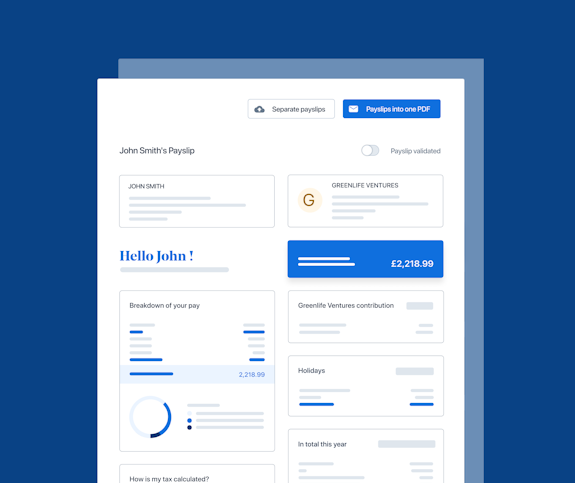- Blog
- |Managing Payroll
- >Payroll data
- >the value of HR
How to demonstrate the value of HR, and get the budget you want


Demonstrating the value of something that isn’t directly measured in pounds and pence, especially to those who hold the purse strings, can be challenging. This will be all too familiar to HR leaders who have tried tirelessly to secure budget for employee health & wellbeing initiatives, L&D programs, or a new People software investment, for example.
These are projects that, when done properly, you know will pay off in the long run, but this might not be immediately clear to budget holders.
A core part of the People leader’s already multi-faceted role, as if anything else needed adding into the mix, is being able to demonstrate the value and importance of HR to the C-suite. This way, you’ll have a better chance of getting your hands on the budget you want in order to do the big stuff. But, as we’ll come onto, doing the big stuff is impossible unless you free up sufficient time to do it.
It all starts with understanding which metrics will help you better communicate the value of HR to your financial decision makers.
Some key metrics to help you demonstrate the importance of HR
It’s true that the concept of HR in the boardroom is one that’s still in the development phase, however getting your foot in the door is the first step on the path to getting the budget you need. The next step is knowing which core metrics will help answer those ‘what is the value of HR?’ questions from the C-suite.
The key lies in aligning the metric with the hoped-for outcome. So if you want to secure budget for an employee engagement drive, point to retention or churn rates; and likewise to get sign-off on bonuses and pay rises, showcase revenue per employee, and so on.
Here’s some key metrics to point to that demonstrate the importance of the HR department to any successful business.
Revenue per employee
Perhaps the simplest of the metrics to calculate, nothing demonstrates the success or value of HR’s efforts better than what each individual employee generates for the business. After all, it’s HR that leads the recruitment strategies and ultimately determines if any given candidate makes it past the screening phase.
At a rudimentary level, it can be calculated by dividing total business revenue by your number of employees. Because, generally speaking, the more productive employees are the more money the company generates in revenue, this metric can help to showcase the success of programs that aim to increase productivity.
Employee engagement rate
Engaged employees tend to be happy employees, and happy employees tend to want to do their best work for you. So when it comes to further showcasing the value of HR initiatives that are focused on employee engagement, you’ll want to be able to quantify that engagement. High engagement should be crucial for the C-suite, as it directly impacts productivity, performance, retention and ultimately profitability.
Conducting thorough employee engagement surveys can provide the metrics you need to show the board how engaged your staff are, and to get the sign off on employee relationship building initiatives, for example. It’ll also give you the insight needed to see where challenges and opportunities exist, and to convince Leadership for time, resources and budget to address those areas.
Retention rate
Few things demonstrate the importance of the HR department’s efforts more than being able to hold onto your best people. Being able to track particular turnover metrics can help you not only take steps to reduce churn, but to understand what might be driving people away.
For example, is it high performers who are leaving in particular, is the average time your employees work for you low across the board, or is there a particular department, job role, age or even gender that tends to quit early? All of these will help inform what specific actions need to be taken. Being able to show the C-suite that you’re on top of employee retention, and demonstrate low rates of churn, will be a great way of demonstrating value, and help to loosen the purse strings.
Gender pay disparity
In 2022/23, a staggering 79% of reporting employers stated that the median hourly pay was higher for men than for women in their companies. Showing the board this stat, plus being able to pull out gender pay gap statistics for your own organisation, could convince budget holders to allocate funds to addressing any gaps. Being able to promote the fact that you’re an equal pay employer will assist your recruitment efforts, promoting you as a caring place to work.
Absenteeism
Understanding whether or not there is an issue with unplanned, unannounced absences, employees starting work excessively late, or finishing early, will help HR teams take the actions required to lower absenteeism, and demonstrate HR’s importance to an organisation overall.
An HR team that is effectively monitoring things in collaboration with team managers - without micromanaging or being overly oppressive - is one that displays to the board that there is true value to be found in the realm of HR, and one that is deserving of budget and resources to help keep rates low.

Getting your hands on budget
Armed with the metrics that will help demonstrate the value of the HR function to your superiors, it’s time to ask the million dollar (possibly quite literally) question - ‘Can we have the budget for what we need?’. In order to get your hands on the cash, there’s a few steps to go through, always being mindful to put forward the metrics that we have spoken about above.
Building the business case
Business leaders will always ask why they should be investing in any particular given project. This is especially the case with People projects, where the return might not be immediately obvious to a decision maker.
Here’s where those metrics come into play - it’s all about promoting the benefits to the business. And whilst it’s monetary benefits, or ROI, that will resonate with the powers that be the most, any tangible outcome backed up by data can help to build a strong business case.
When it comes to showcasing the value of HR, pointing to both good and bad metrics can help build a business case. For example, highlighting a low revenue per employee figure in a particular department might increase your chances of getting sign-off on productivity or engagement initiatives within that department. And on the flip side, pointing to high retention rates shows the value of your work, and builds the case for continued trust and budget for your projects.
Put simply, building a business case for getting that budget is about saying to your superiors - ‘A is happening, and if you want to achieve B, I’m going to need to do C, and this is what I need for that to happen.’
Getting stakeholder buy-in
Stakeholder engagement is fundamental to the success of any new project pitch. Identifying who those stakeholders are is a key first step, and they will likely vary depending on the nature of the project. Some good people to prepare your pitch for would be a Head of HR / Culture / People (if that’s not you), CFO and CEO (who’ll have final say over the budget).
It��’s also important to understand your stakeholders’ frustrations, and how your proposal(s) will help them and the wider business. State their problems back to them, and how your solution will help them and the company.
The difference between a budget proposal being successful or not could rest on how well you’re able to build a support network of advocates amongst colleagues. Budget holders will be more likely to give you the green light for your People initiative if they see how it will benefit multiple individuals or teams within the business. So get some friends and colleagues involved and ask them to contribute their unique business cases towards your project.

Creating the time for those valuable HR initiatives
So, you’ve got the sign-off for your big People project. Congratulations! Now, you’ve got to find the time to do it, and we know that time is a precious commodity in the HR department. Too much of it is often taken up with manual, admin-heavy tasks. So, the key to freeing up that time is to streamline, or even automate, those tasks.
Take managing payroll for instance.
One HR operations team leader we work with chose to automate her payroll processes with us in order to free up the time to onboard 160 new joiners. It also meant she was finally able to integrate their existing HR system with payroll, something that had to be put on hold previously because there simply wasn’t the time or resource to be able to do it.
Imagine what ROI-driving initiatives you could work on with those extra days back in your calendar each month.


A UK 4-Day Working Week - Thoughts On Labour’s Plan

Running payroll - A Guide For New Businesses

The Alabaster Ruling & Maternity Pay - A Guide For Employers

The End Of Zero Hours Contracts? Implications For Businesses

What is the HM Revenue and Customs Starter Checklist

